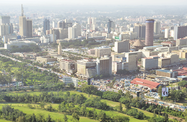Last year Kenya saw robust economic growth, thanks in part to a smooth conclusion to the March presidential elections as well as to the discovery of new hydrocarbon deposits and aquifers. Planned reforms and devolution look set to improve the overall business environment over the course of 2014, although the East African nation still faces challenges, including the end of tariff exemptions for key exports to the EU and continued instability in its northern neighbours.
The IMF estimates GDP growth for 2013 at around 5.9%, with expansion forecast to continue at a healthy pace in 2014, rising to 6.2%. Growth came on the back of rising domestic consumption as well as an increase in capital inflows, brought about in part by an increase in infrastructure activity. It was not all smooth sailing however, particularly for the agriculture sector, which accounts for around a quarter of GDP. The country is a major producer of flowers, tea and coffee, which represent the country’s second, third and fourth largest foreign-exchange earners respectively. Although production in the first part of the year increased and revenues were comparatively stable, a decline in international prices for cash crops combined with droughts in the east and northeast, and outbreaks of disease, made for a much tighter environment for farmers.
The Westgate shopping centre attack in September also represented a major concern for the country’s economy, but fears of investor flight did not materialise – as of late December, the value of the NSE All Share Index was up around 10% since the attack.
Indeed, headline indicators in most sectors were generally fairly strong. In the financial sector, the Nairobi Stock Exchange (NSE) boomed last year, with the value of the NSE All-Share Index up nearly 45% for the year-to-date as of late December. Looking ahead, 2014 should bring more opportunities for financial investors seeking exposure to the country, through the planned issue of the first Kenyan Eurobond. The government reportedly aims to raise $1.5bn through the bond, making it sub-Saharan Africa’s largest debut issue to date. The funds will be used largely to finance infrastructure developments.
The government has also overseen a gradual devolution of power to a new set of governmental entities. Shortly after Uhuru Kenyatta’s narrow victory during the presidential elections in March – which avoided a repeat of the violence that followed the previous round of polls in December 2007 – new county-level governments were established, as set out by the 2010 constitution, with local authorities now responsible for administering some tasks previously carried out by the central government. Although concerns have been raised over the governance capacity of the new counties, it is hoped the devolution will help improve local oversight and strengthen development, particularly in rural areas.
Important natural resource discoveries
The economy received a major boost from a series of underground developments. In September the government announced the discovery of two large water aquifers in the arid Turkana region in the north-west. Together these are estimated to contain around 250bn cu metres of water, more than 80 times the country’s annual consumption. Furthermore, the aquifers have an estimated annual recharge rate of 3.4bn cu metres, exceeding estimated yearly usage, suggesting they can be drawn upon for an indefinite period.
The burgeoning oil industry also saw important new finds. Following two discoveries by partners Tullow and African Oil at wells in the Lokichar basin in Turkana in 2012, the two companies together struck oil in three more locations in the basin in 2013, in July, September and November. Commercial production of oil is expected to begin in 2016 and the discoveries have sparked interest in remaining licences from some of the largest international energy firms.
Global and regional trade
2014 will prove a crucial year for exporters, who have been grappling with the low levels of growth in the EU, the country’s primary trading partner. Agriculture accounts for a large share of exports, which overall were down 0.7% in the first nine months of the year on the same period in 2012. Exports to Europe, which accounted for around 40% of overseas sales in 2012, may come under further pressure in 2014, with the EU saying it could terminate a temporary trade agreement with the East Africa Community (EAC), of which Kenya is a member, this year.
Without special terms, Kenya will face tariffs of up to 16% on its exports to the EU under the General System of Preference. The higher tariffs are based on Kenya’s UN classification as a “developing country”. The other members of the EAC – Uganda, Tanzania, Rwanda and Burundi – are classified as “least-developed countries”, and so can continue to export goods to Europe with no duties or quotas under the EU’s “Everything But Arms” initiative.
Meanwhile, efforts continue apace to further integrate the EAC community. Among other initiatives aimed at reducing non-tariff trade barriers, a single Customs territory among Kenya, Rwanda and Uganda came into effect in September. At the 15th EAC Summit, held in Uganda in December, leaders of the five member states endorsed a monetary union protocol, which will pave the way for a common currency. According to a joint statement read at the conference by Kenyatta, who recently took over the group’s chairmanship, a single currency will reduce transaction costs and minimise currency fluctuations, boosting levels of trade and investment.
Follow Oxford Business Group on Facebook, Google+ and Twitter for all the latest Economic News Updates. Or register to receive updates via email.

